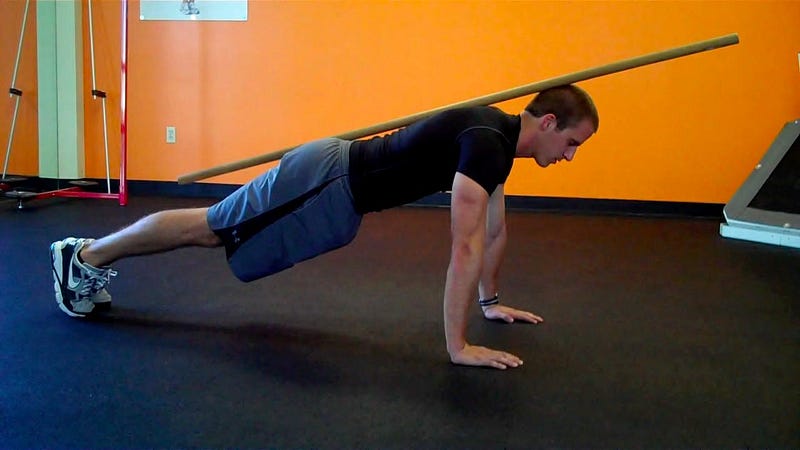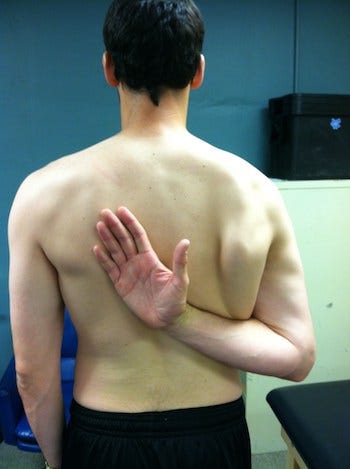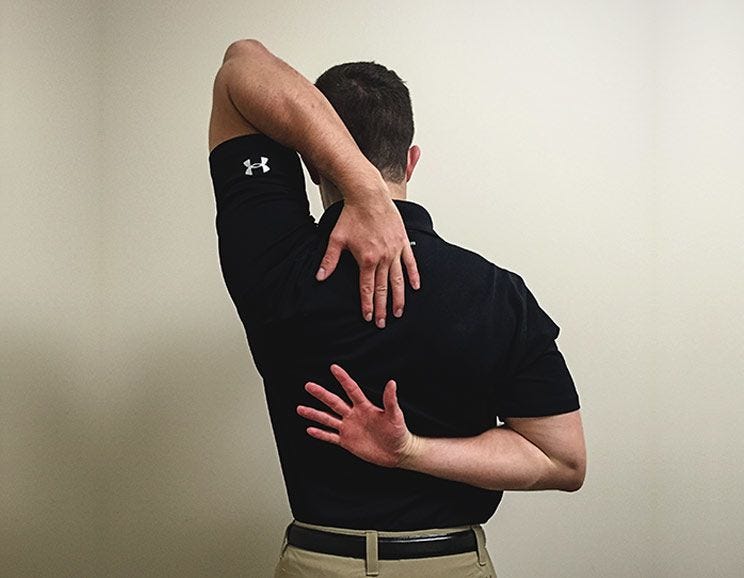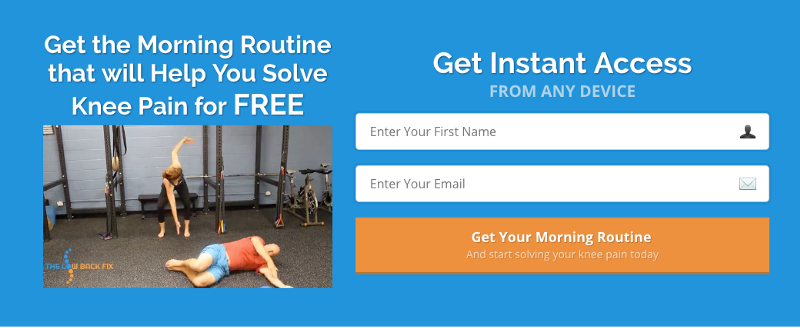The Shoulder Fix: Eliminating Shoulder Pain in the Strength Athlete

Acute pain in a shoulder at the young women. young girl keeps for a sick shoulder on a white background

Shoulder Suicide
You aren’t lifting weights just to burn off calories or aggression. The gym is your sanctuary to test yourself, find your upper limits, create goals, and smash them.
The barbell has a simple way of calibrating input to test human output. You put ten pounds on the bar and your body must adapt. Incrementally, those adaptations lead to increased strength, PR’s, and, unfortunately, nagging injuries.
Over 80% of the movements found in functional fitness gyms use the shoulder joint. It is the most mobile and vulnerable joint in the body. Every time you snatch, jerk, push, pull, and swing, your shoulder is being put through a massive range of motion, under heavy load, at high intensity.
The shoulder comes with extreme complexity. The large movers of the upper body — the traps, rhomboids, teres major, pec, and rotator cuff — attach at the neck, spine, and shoulder blade. Their primary role is to create stability in the shoulder, scapula, and spine. To protect the shoulder, these muscles must be strong to handle external load, mobile to hit end ranges of motion, and stable to control movement throughout these ranges.
Strength, mobility, and stability are the result of deep core musculature protecting the spine. Lacking balance in any of these domains places excess demand on the rotator cuff leading to chronic pain and injury. Your responsibility as an athlete is to protect the joint and arm yourself with the tools to keep it healthy.

A Movement Laboratory
I never want athletes to be injured, however, it happens. When it happens, it presents a transition point, an opportunity.
The short-term solution is to bear down, push through the pain, and keep charging.
The second, smarter option is to recognize injury as an opportunity to learn. A moment to dissect your movement patterns, slow down, and refocus your energy towards getting healthy.
It is obvious the gym is a place to develop strength. More importantly, it is a laboratory for human movement. A place to assess the capabilities of your joints, tissues, and movement patterns across an array of tests.
Shoulder extension vs. shoulder flexion issues
- Does your shoulder hurt in the bottom of a muscle up, dip, or push up? The silver lining is you get to learn about improving shoulder extension.
- When you snatch, jerk, or press overhead, do you feel pain? If so, time to dig into understanding shoulder flexion and external rotation.
Just like any laboratory setting, there are unexpected “a-ha” moments. One of your first “a-ha” moments is that shoulder pain is a symptom of poor core strength and stability. Once you learn how to breathe and stabilize your spine you will learn you do not actually have a shoulder problem. A-ha!
How Are Your Shoulders? Screening Shoulder Extension
The perfect push up position
- Start in a standing position, with your palm forward, and pull your arms in a straight line behind your body. In this extended position, bend at the elbow bringing your hands in line with your chest. Without the weight of your body, this is the bottom position of the perfect push up. The elbows are in to your side, the shoulder is internally rotated, and your hand is directly under the shoulder.
- Be honest with yourself. Do all of your push-ups look like this?
While the push-up seems so simple, it is the baseline movement screen for understanding shoulder extension and internal rotation. Too often, as you speed through your push ups, your elbows start to flare out. As the elbows drift away from the body, the shoulder has to compensate. This internally rotated position lacks stability and applies excess pressure to the front of the shoulder.
You want large joints and muscles carrying the bulk of the load. In the upper body the chain of events follows the shoulder, then elbow, and finally the wrist. To ensure these movement principles are met, the first movement of the push up is not down, it is forward. The chest moves forward to load the shoulders, then the body can descend by driving the elbows back, and slowly lowering the chest to the ground.
Shoulder Extension Movement Exercise
DO THIS: With the ‘big joint to small joint’ principle in mind, place a PVC pipe on your back, maintaining three points of contact (head, back, and butt) perform 5 push-ups each with a 5 second descent. Are you pain free?

The principle of shoulder extension is universal, but the expression of this principle can take many shapes. Let’s apply the same principle to other movements:
Dip — A dip requires the same shoulder extension, but increases difficulty because your bodyweight is not supported by your feet
Muscle Up — The muscle up challenges this position through an athletic, dynamic movement that requires you to catch the weight instead of slowly lower into a good position.
Shoulder Extension Self-Assessment
To see if your shoulders are functional enough to perform these movements well over many reps, try this self-assessment: Can you reach up your arm behind you to touch the bottom of your opposite shoulder blade? If you find it difficult, or at the opposite spectrum your hand easily slides far up your shoulder blade, that’s a problem.

A Disaster Overhead: Screening Overhead Movements
You are going to lift the weight. I know it. Your legs are strong, your technique is getting dialed in, and that weight is going over your head. Standing the weight up however is a different story. Your shoulders round in, you take five steps to stabilize the bar overhead, and then wonder why your shoulders hurt the next day after snatching.
The overhead position is the hardest position for modern day humans to master. You spend too much time in your car and at a computer to walk into the gym and undo the poor posture you have been practicing all day. The scapula is the big player in overhead shoulder health. The shoulder must have the proper mobility and stability to upwardly rotate just enough to stabilize the shoulder overhead. The traps are there to support the scapula by providing strength and stability to the shoulder overhead.
As the arm flexes overhead, any mobility restrictions in the lat will limit the shoulder from its full range of motion. When the shoulder stops short, the connective tissue in the rotator cuff bears the brunt of the load. In the short-term, your body will allow you to keep training. Over time, the connective tissues will not be able to handle the load and volume leading to inflammation and injury.
Overhead Movement Exercise
DO THIS: Strict press a barbell (45#/35#) for 5 reps each with a 5 second descent. Are you pain free? The way your shoulder performs is based on the position of your spine. Your midline musculature ensures the shoulder and scapula are set up for success.
Overhead Self-Assessment
To see if your shoulders are functional enough to perform overhead movements consistently over time, try this self-assessment: Can you reach up and touch the top of your opposite shoulder blade with the hand? (No bending, scrunching the shoulders, extending the low back or wiggling your way to into position.) If you find it difficult, or at the opposite spectrum your hand easily slides well past your shoulder blade, that’s a problem.

Shhhhh, It’s Not Actually Your Shoulder
Behind every pain free lift is a strong core built through quality breathing. Core stability is the centerpiece of shoulder health. Whether the shoulder is in flexion or extension, a solid core provides the foundation for quality movement. The more stability you create in your core, the more your brain recognizes safety to the spine, creating increased mobility to the surrounding tissues and joints.
The core I am talking about is not your sweet six pack. Your deep core consists of the diaphragm, multifidus, intercostals, pelvic floor, and transverse abdominus. Lumped together, we call them “The Core of the Core.” Individually, they have a specific role for strengthening and stabilizing the joints and connective tissues supporting the spine. There is no amount of sit ups you can do to train these deep core muscles.
The only way to get in there is through diaphragmatic breathing protocols that expand the rib cage and decompress the spine. The tissues of the pelvis, thoracic, neck, and shoulder will also benefit from diaphragmatic breathing protocols. The breath decreases recovery time, stress, and allows the tissues to work more efficiently.
Breathing Exercise
DO THIS: Start laying on your back and take a deep breath in through your nose expanding your abdomen, and then your chest, with air. Breathe in for 5 seconds. At the top hold your breath for 5 seconds and slowly exhale, through pursed lips, for 5 seconds. As you exhale, create tension in your abdomen. With each continuous breath, maintain the tension in your core as you inhale and exhale. Do not let your spine change position as you breathe.
What to Do? Start with a Morning Routine for Shoulder Pain
Getting from pain to performance takes action. That action however does not need to be life altering. It needs to be consistent and provide all the components to helping your shoulder heal (not just the joint itself). Breathing, moving, and stabilizing are free and you do not need a doctor or trainer to prescribe them. We know you love training and our goal is to get you healthy as soon as possible.
To get you on your path to health, we have designed a morning movement routine specific to shoulder health. Inside you will find breathwork, mobility, and stability drills to eliminate the unhealthy mechanics of your shoulder and spine. Simply put, if you have shoulder pain, this is exactly what you need to do every single morning to be pain free.
Even better, it is all free. Click here to gain instant access.

Thanks for reading!
Anders
Resources:
1 jblack03. Evaluation of the Weak Shoulder. UW Orthopaedics and Sports Medicine, Seattle. Published August 13, 2015. Accessed February 14, 2018.
2 Kibler WB, Press J, Sciascia A. The Role of Core Stability in Athletic Function. SpringerLink. Published November 27, 2012. Accessed February 14, 2018.
3 Hazar Z, Ulug N, Yuksel I. Is There a Relation Between Shoulder Dysfunction and Core Instability?Orthopaedic Journal of Sports Medicine. 2014;2(11_suppl3). doi:10.1177/2325967114s00173.
4 Disorders of the Scapula and Their Role in Shoulder Injury. Google Books. Accessed February 14, 2018.

Leave a Reply